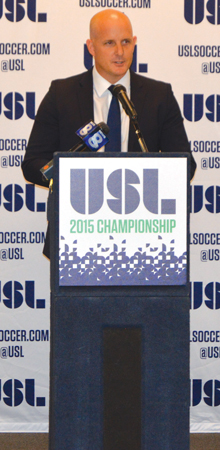The start of the United Soccer League’s 2016 season this week comes with a number of key additions: six new franchises; two new ownership groups; and the opening of another soccer-specific stadium, making it eight in play leaguewide.
But for USL President Jake Edwards, named to the position in March 2015, the league’s eyes remain focused on a long-term growth plan he helped design. That plan, Destination 2020, paints a picture of a league with upward of 40 teams across the country but centered on local rivalries, and each playing in its own soccer-specific stadium with between 5,000 and 10,000 seats.
 |
Jake Edwards envisions a league with upward of 40 teams across the country.
Photo: COURTESY OF THE UNITED SOCCER LEAGUE
|
“Our ambition is to be the top second division in the world,” said Edwards, a former professional soccer player who joined the USL in 2013 after working as a strategy consultant for Octagon in England. “Look at the [Football League] Championship. It may be considered second division in England, but it’s one of the largest leagues in Europe. Is that a good goal to aim for? Absolutely.”
This year’s USL season begins on Friday. While the league in its current form played its inaugural season in 2011 — it underwent a rebrand last year, changing its name from USL Pro — its roots extend to the 1990s. Its history is marked with starts, stops and clashes with the NASL, which splintered from it in 2009.
The USL is considered a third-tier league in the eyes of the U.S. Soccer Federation, sitting behind MLS and the NASL. It’s applied for second-tier status, though, a move that requires it to have certain benchmarks in attendance, stadium size and ownership control — but potentially, in turn, opening the door for higher-dollar sponsor and media deals in support. Edwards said a decision is expected later this year.
As there is no promotion or relegation in the U.S. soccer system (unlike other soccer associations around the world), two leagues can occupy the same tier.
A partnership with MLS, signed in 2013, has served to strengthen the USL. The deal calls for all 20 MLS clubs to either own or operate a team within the league, or to have an affiliate relationship with a club. That deal comes as MLS in its own right expands to 24 clubs (from 20) in the coming years, with talk of perhaps additional clubs as well.
About USL
■ President: Jake Edwards
■ No. of teams: 29 (last year: 24)
■ New ownership groups this season:
• B Sports Entertainment, led by tech entrepreneur Eric Bowman (Charleston Battery)
• David and Wendy Dworkin, minority owners of the Sacramento Kings (Rochester Rhinos)
■ No. of soccer-specific stadiums: 8 (new for 2016: RGVFC Stadium in Edinburg, Texas)
Source: USL
The USL has already announced that a Reno, Nevada, franchise will join the league in 2017. Its Austin, Texas, franchise is sitting out this season following damage to its stadium from flooding in central Texas last year but could return in 2017 as well.
“We’ve been able to move quickly, as you can see in the growth of the size of the league, but we want to make sure we’re building with the future in mind,” Edwards said.
For some USL club owners, that future includes MLS team ownership. The ownership groups in Sacramento and San Antonio, for example, have been open about desires to advance to compete as MLS franchises. Edwards sees no problem in that objective.
“I’d like to challenge all of our clubs to be operating at a level where it starts to look like MLS expansion could work in that market,” he said. “That can only be good for us as a league, good for our clubs and ultimately good for everyone. It’s just part of the dynamic of soccer in this country.”
USL operates with a staff of 35 full-time employees, but growth is expected in its corporate sales area in particular. Edwards anticipates that group will be shopping a package of commercial and media rights for the league by the second or third quarter of this year. Its lead sponsor is Nike.
Game broadcast plans for this year were still being finalized last week. For the last two years, the league has streamed its games via YouTube, with its 2015 championship game appearing on ESPN3 as well.
Edwards said a relaunched USL website, scheduled to debut this week, will be used for streaming games live — but also as a template to bring all of its clubs onto a single platform over the next 18 months. The USL is working digitally with NeuLion, and its game production efforts are overseen by consultant Michael Cohen, the former head of production and executive producer for MLS.
On the stadium front, USL last May signed a deal with HOK calling for the company to lead a stadium development, design and standards initiative leaguewide. Edwards said the past year has seen USL teams collectively spend $100 million on venue upgrades drawing from those enhanced standards. This year, the focus will be on bringing new developments to cities where existing structures do not reflect the league’s growth plan. A prototype stadium design, with a capacity of 10,000 but an ability to scale up, is expected to be unveiled in the next 60 days.
Most of the league’s stadiums are less than 10,000 in capacity. USL teams averaged 3,369 fans per game in attendance last season. Just one team averaged more than 7,000 fans per game last year: Sacramento, at 11,323.




